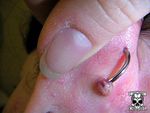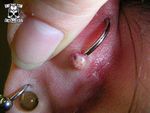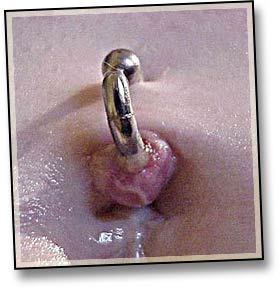Boil
Jump to navigation
Jump to search
- This article is about the medical condition. For information on boiling water to sterilize jewelry, see Boiling.
A boil is a hard, painful pus-filled sore of the skin and subcutaneous tissue. It is usually caused by a local staphylococcal infection or other bacterial infection. Most of the time, boils develop at the exit points of piercings after damage occurs (either from the actual piercing itself, or subsequent injuries such as tears). They can happen in all types of piercings; at right, you can see a boil on an inner conch piercing.
Treatment
Boils are generally treated with hot compresses, although you can also pop and drain them like acne. However, that could easily lead to more irritation, more bacteria in the wound, and escalating problems. Dustin Sharrow wrote us to add:
- Treatment consists of several hot compresses per day. Effective treatments have included everything from herbal soaks to saltwater, though an antibiotic ointment applied twice per day yields the best results. If and when the boil ruptures, bleeding should be encouraged in order to drain the boil of blood and pus. A doctor may prescribe oral antibiotics as well, and healing can take from 10 to 30 days.


